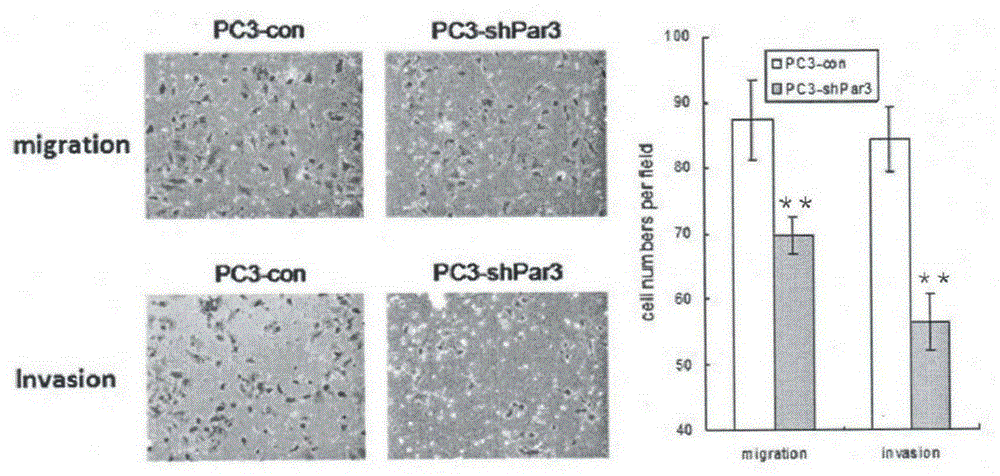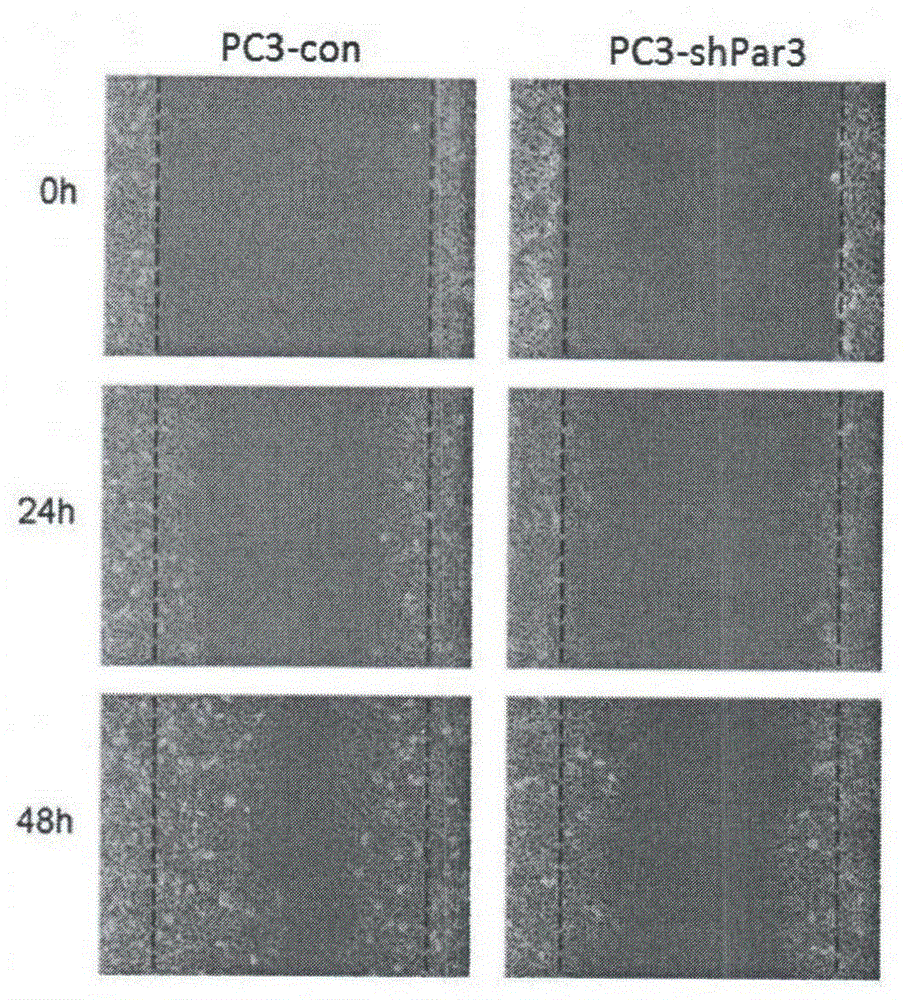Inhibition of invasion and transferring of prostatic cancer by utilization of targeting polar molecule Par3
A prostate cancer, 1.par3 technology, applied in the field of biomedicine, can solve the problems that the specific mechanism of prostate cancer metastasis is not yet clear, the upstream signal and signal transduction regulation mechanism are unknown, etc.
- Summary
- Abstract
- Description
- Claims
- Application Information
AI Technical Summary
Problems solved by technology
Method used
Image
Examples
Embodiment 1
[0042] A subcloned cell line PC3-shPar3 stably knocking down Par3 and a control PC3-con were constructed and identified in the prostate cancer cell line PC3 (the human prostate cancer cell line PC3 is used here as an example, but not limited thereto).
[0043] Prostate cancer cell line PC3 was purchased from the Cell Bank of the Chinese Academy of Sciences, and Par3 interference plasmids (pshPar3#1, pshPar3#2) and control plasmids were purchased from Origen Company (Cat. The designed shRNA against Par3 (i.e. shPar3#1 and shPar3#2), also contains a control backbone plasmid). Will 1x10 6 PC3 cells were seeded in 6-well plates, and 24 hours later, the Par3 interference plasmid and the control plasmid were transfected with lipofectarmine2000 transfection reagent (purchased from LifeTechnology Company). 72 hours after transfection, the cells were transferred to a culture dish with a diameter of 10 cm by a conventional adherent cell subculture method and expanded to culture until t...
Embodiment 2
[0046] In vitro transwell experiments (using PC3-shPar3 and control PC3-con cells as examples, but not limited thereto).
[0047] BD company's transwell cell culture plate (the size of the mesh at the bottom of the upper chamber with a pore size of 8 microns) was used to conduct tumor cell migration (without matrigel coating) and invasion (with matrigel coating) experiments. Adherently cultured PC3-con and PC3-shPar3 cells were serum-starved for 24 hours, digested and prepared a serum-free cell suspension at a density of 5x10 5 / ml. 100 microliters of cell suspension was added to the upper chamber, 700 microliters of medium containing 10% FBS was added to the lower chamber, and the cell culture plate was routinely cultured in a cell culture incubator. For the migration experiment, after 4 hours of conventional culture, the upper chamber was taken out, and the residual cell suspension inside the chamber and on the screen was sucked off using a micropipette. The upper chamber ...
Embodiment 3
[0049] Scratch test (using PC3-shPar3 and control PC3-con cells as an example, but not limited thereto).
[0050] PC3-con and PC3-shPar3 cells that were conventionally adhered to the wall were digested with trypsin and seeded in a 6-well plate at a seeding density of 70%-80%. Routine culture in the cell incubator for 24 hours after inoculation to ensure that the cells completely cover the bottom of the culture plate. Use a 1ml micropipette tip perpendicular to the orifice plate and use a scale to assist in scratching, try to ensure that the width of each scratch is consistent. After scratching, the cell culture medium was sucked off, and the plate was washed twice with PBS to wash away the cell debris produced by the scratching. Add DMEM containing 2% serum for routine culture in a cell culture incubator. Three time points of 0 hour, 24 hours and 48 hours after the scratch were selected, and microscopic photography was performed under bright field using a phase contrast micr...
PUM
 Login to view more
Login to view more Abstract
Description
Claims
Application Information
 Login to view more
Login to view more - R&D Engineer
- R&D Manager
- IP Professional
- Industry Leading Data Capabilities
- Powerful AI technology
- Patent DNA Extraction
Browse by: Latest US Patents, China's latest patents, Technical Efficacy Thesaurus, Application Domain, Technology Topic.
© 2024 PatSnap. All rights reserved.Legal|Privacy policy|Modern Slavery Act Transparency Statement|Sitemap



